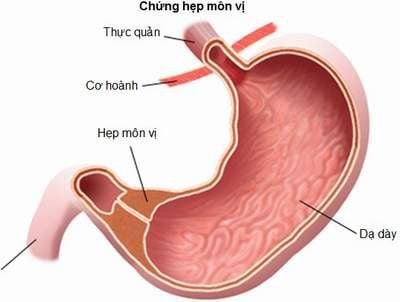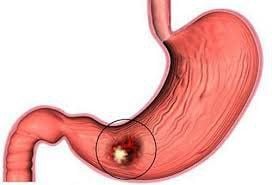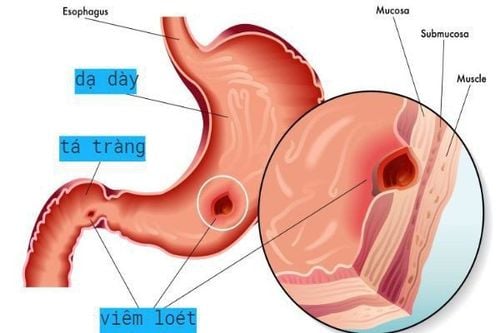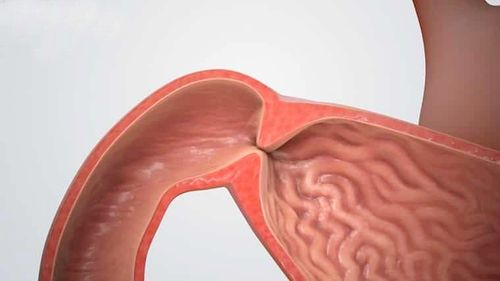This is an automatically translated article.
The article is professionally consulted by Master. BSCK II Phan Thi Minh Huong - Gastroenterologist - Department of Medical Examination & Internal Medicine - Vinmec Da Nang International General Hospital.Pyloric stenosis, also known as pyloric obstruction, occurs mostly in infants under 6 months of age, especially in boys. Common symptoms in patients are: vomiting, pain due to stomach cramps, dehydration, weight loss.
1. What is pyloric stenosis?
The pylorus is located at the end of the stomach at the junction with the duodenal bulb. The pylorus is the muscular valve-like organ that holds food in the stomach until it is ready to be passed down to the small intestine and continue the digestive processPyloric stenosis is a syndrome with the general presentation of The circulation of food and gastric juice to the duodenum is obstructed or completely stopped. Specifically, the phenomenon of food stagnation in the stomach cannot enter the intestines or is very limited.
Consequences of pyloric stenosis will lead to an enlarged stomach, fluid and food stagnation in the stomach after 6 hours has not yet circulated.

Hẹp môn vị
2. Causes of pyloric stenosis
There are many causes of the disease, so parents should not be subjective before the manifestations of the disease. Because, there are benign causes but there are also malignant ones, which can be dangerous for the patient. If not treated promptly, it will quickly lead to disturbances in water and electrolyte metabolism, and total body exhaustion due to impaired gastrointestinal circulation.It can be seen that in the human body, the thick skin includes the cardia, the gastric aneurysm, the body, the stomach, and the pylorus. Therefore, the pylorus and the stomach are closely related and influence each other. When a certain part of the stomach is damaged (inflammation, ulcer, cancer) it affects the pylorus, and vice versa, when the pylorus is not normal, it affects other parts of the stomach. and duodenum.
There are some objective causes leading to pyloric stenosis in children due to genetic factors. That is, if a child has a close relative who is a parent or grandparent with pyloric stenosis, this child will have a higher risk of disease than other children.
Mostly, pyloric obstruction comes from gastroduodenal disease. Pyloric stenosis may be caused by acute inflammation of the stomach or duodenum. But through the exacerbation of gastritis - duodenum, the pylorus returns to its original state, for example, acute alcoholic gastritis, due to food poisoning.
Previously, duodenal ulcer was a common cause (5-15%), due to large ulcers, calluses causing deformation and narrowing. Currently, due to new understandings of the pathogenesis and treatment of ulcerative diseases, pyloric stenosis due to ulcers is significantly reduced (2 - 5%).
Some cases due to inflammation, duodenal ulcer, especially gastric ulcer - duodenal ulcer, or ulceration of small curvature near the pylorus for a long time, causing the organization of the duodenum to become fibrosis, pulling, causing stricture taste (sclerotic duodenal ulcer).
There are cases of malignant pyloric stenosis that pose a great danger to young children as gastric pylorus cancer. The rate of cavernous-pyloric cancer is common in gastric cancer, ranging from 20 to 60%. It is these tumors that narrow the lumen of the pylorus with inflammation, making the lumen of the pylorus narrow, and food and gastric juices are difficult to pass or cannot pass to enter the intestine.
In addition, there are many causes leading to pyloric obstruction in the stomach and outside the stomach:
In the stomach: Benign tumors of the pyloric region, usually pyloric polyps, the antrum descending causing pyloric obstruction ; prolapse of the gastric mucosa through the pyloric orifice; stomach muscle seo; pyloric stenosis; lymph nodes in Hodgkin's disease; Stomach burns scars caused by ingestion of acids and alkalis. Outside the stomach, such as: ectopic pancreatic ring in the pyloric region; pancreatic tumor invading pylorus, duodenum; Periduodenal adhesions due to cholecystitis, after cholecystectomy...

Loét dạ dày, tá tràng cũng có thể là nguyên nhân dẫn đến hẹp môn vị
3. Is pyloric stenosis dangerous?
Pyloric stenosis may not be dangerous to young children if detected and treated promptly. Symptoms of pyloric stenosis are flatulence, abdominal distention, epigastric pain, especially after eating, and vomiting of recently eaten foodIf the disease progresses, it will be very dangerous and painful Children due to stagnation of food and gastric juice, pain when lying down, sitting up is better. When the patient lies down and changes position, he or she can hear the murmur in the abdomen, if the patient lies on his back, he will see a flat stomach (concave abdomen). People are often thin, pale, tired, craving food but do not dare to eat because eating hurts more.
In many cases, when suffering from pyloric stenosis, the patient will vomit the food of the previous day, accompanied by a strong odor of gastric juice. Vomiting so much will be accompanied by dehydration and electrolytes, making the patient more tired, uncomfortable, thin, blue skin, sunken eyes, dry skin and irritability.
Doctor Huong has over 30 years of experience in the field of Gastroenterology, in which with nearly 20 years holding the position of Deputy Department, Head of Department of Hue Central Hospital. Currently, he is a Doctor of Gastroenterology - Gastrointestinal Endoscopy - General Internal Medicine Department of Vinmec Da Nang International General Hospital.
Please dial HOTLINE for more information or register for an appointment HERE. Download MyVinmec app to make appointments faster and to manage your bookings easily.













